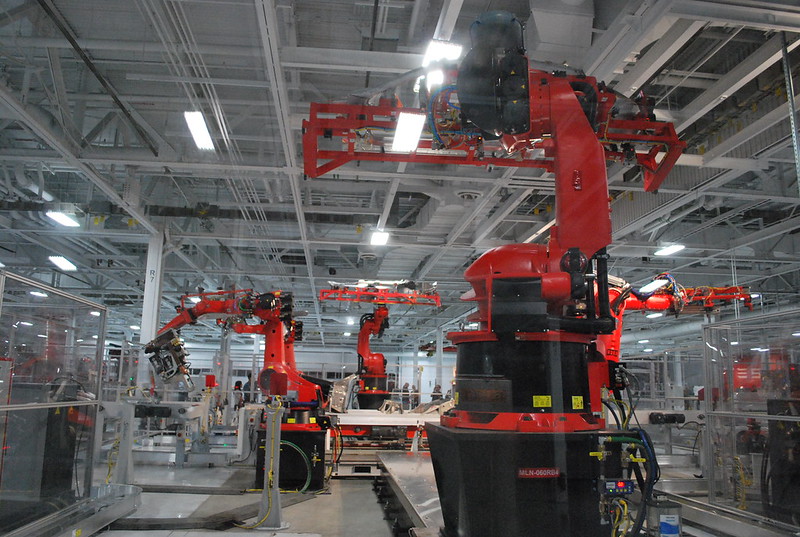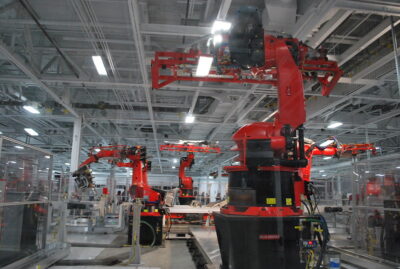- August 30, 2023
- Posted by: David Marshall
- Category: Digital Transformation

The digital revolution has created some amazing innovations, like self-driving cars and smartphones that are basically computers you can call people on. The digital revolution is also spilling over into the manufacturing world and giving it some serious upgrades.
If you’re still operating an old-school factory — and there are many factories still firmly entrenched in the 20th century — then you need to know some of the technologies that can either make your jobs easier or will ultimately replace you.
1. 3D Printing
3D printing (or additive manufacturing) has grown far beyond prototyping. It’s now part of full-scale production, supporting intricate designs that were once unattainable in traditional manufacturing. Advanced 3D printing technologies like selective laser sintering (SLS) and stereolithography (SLA) provide greater accuracy and material diversity. This is the kind of tech they’re using in aerospace, healthcare, and automotive manufacturing.
Additive manufacturing is also accelerating the transition to just-in-time manufacturing. It allows companies to skip expensive molds and avoid producing very large batches of small products just to get a price break. This reduces inventory overhead, lets companies make real-time adjustments based on the market, and reduces the amount of time it takes to launch new products.
3D printing can also work with other technologies, like AI-driven generative design, which lets you compute the most effective and material-efficient designs, and immediately print them into physical reality. (Think about the first Iron Man movie where Tony Stark basically told his computer, Jarvis, to build him the first Iron Man suit.)
2. Digital Twinning
 Digital twinning is an important part of the Internet of Things (IoT) ecosystem because it gives real-time analytics and feedback to complex manufacturing systems. Digital twinning lets you operate a virtual, digital factory to simulate your operation, integrate your sensor data, and do things like predict machine failures, optimize supply chain logistics, and even help innovate new products.
Digital twinning is an important part of the Internet of Things (IoT) ecosystem because it gives real-time analytics and feedback to complex manufacturing systems. Digital twinning lets you operate a virtual, digital factory to simulate your operation, integrate your sensor data, and do things like predict machine failures, optimize supply chain logistics, and even help innovate new products.
You can also combine real-time data analytics with machine learning, which allows self-updating, self-correcting systems that refine their predictive models based on actual performance data. This continuous loop lets manufacturers deal with issues before they become problems. You can also streamline maintenance schedules and reduce downtime.
By integrating data from multiple sources — including production, sales, and customer feedback — digital twins can create a comprehensive view of your products’ lifecycles. This can reshape the future of manufacturing by letting you make more intelligent, data-driven decisions, rather than reacting to problems and putting out fires.
3. Artificial Intelligence (AI)
Machine learning algorithms, which are part of a digital twinning system, now run predictive maintenance models that anticipate machinery failures and proactively schedule repairs. Similarly, neural networks are revolutionizing manufacturing QC functions by analyzing production lines in real time and finding defects faster and more accurately than any human.
AI is also useful for optimizing supply chain logistics by analyzing complex variables that affect your supply chain — say, seasonal demand fluctuations or geopolitical events — and automatically adapting ordering schedules or shipping and routing options. The systems don’t just react, they learn from the past in order to make better decisions, making the manufacturing process more resistant to disruptions.
Now, imagine combining AI with things like digital twinning and 3D printing — this is what is often called “Industry 4.0,” which is a new way of thinking about manufacturing. It uses data and interconnected digital systems for more holistic optimization.
4. Blockchain: The Trust Builder
If you’ve heard about Bitcoin, then you’ve heard about blockchain. But did you know that blockchain can be a game-changer for digital manufacturing too? Okay, let’s break this down a bit. A blockchain is a system that records information in a way that’s super secure and almost impossible to mess with.
So how does it fit into manufacturing? Well, one word: trust. In a world where products are made up of parts from different places, it can be hard to keep track of it all. Who made what? Is it high quality? Has it been tampered with? Blockchain can answer these questions.
For example, let’s say you’re buying a bike. With blockchain, you can trace back each part of that bike to its origin. You’ll know where the metal for the frame came from, who provided the rubber for the tires, and so on. This kind of transparency is great for businesses and consumers alike. It means that everyone can trust that the products they’re getting are up to snuff.
Plus, if a part of something does turn out to be faulty—like a brake on our hypothetical bike—you can find out exactly where the problem came from and fix it, without having to throw the whole thing away. This not only saves money but also reduces waste, making manufacturing more sustainable.
5. Big Data and Analytics
Big data and analytics are more than just dashboards and reports these days. Advanced analytics platforms now use things like time-series analysis, cluster analysis, and sentiment analysis to understand complex manufacturing patterns. By using machine learning, these analytics platforms can not only interpret past and current data, but they can also predict future trends and offer actionable insights.
Insights like demand forecasting. By gathering data from a variety of sources — such as customer behavior, market trends, and social media chatter — analytics tools can predict demand with a high degree of accuracy. (Imagine being able to do that during the Tickle Me Elmo craze!) This allows manufacturers to adjust production schedules and allocate resources, which helps them better meet the market needs.
Final Thoughts
These emerging technologies are letting manufacturers make things faster, cheaper, and more customizable. Companies can be smarter about what they make and how they make it. They’re enabling manufacturers to find new efficiencies, save time and money, and increase their profits. But don’t wait too long, or you’re going to spend all your time catching up while your competitors are already looking at what the next wave of the future is going to bring.
I’ve been a manufacturing executive, as well as a sales and marketing professional, for a few decades. Now I help companies turn around their own business, including pivoting within their industry. If you would like more information, please visit my website and connect with me on Twitter, Facebook, or LinkedIn.
Photo credit: Patrick Herbert (Flickr, Creative Commons 2.0)

